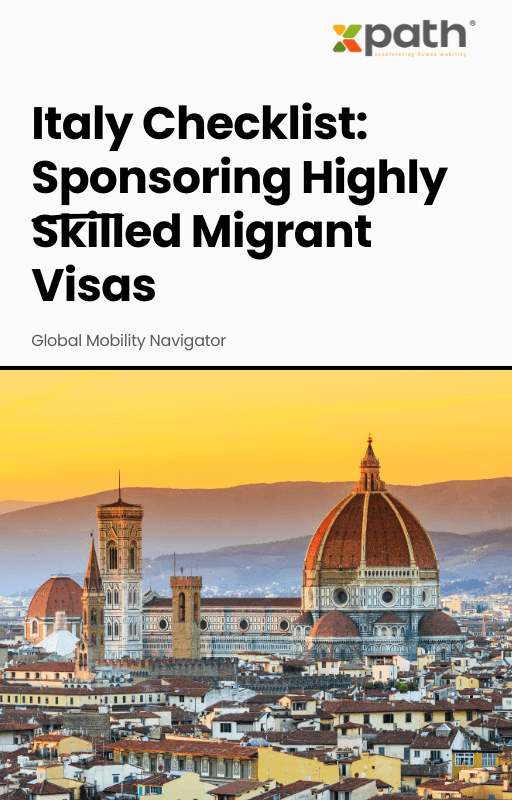Italy Checklist: Sponsoring Highly Skilled Migrant Visas
Grab a copy of a guide to international employee relocation
View E-bookThese dilemmas, while not entirely new, are gaining importance due to demographic shifts, technological advancements, and evolving business practices. It is essential for mobility and HR teams to understand and address these dilemmas strategically. By doing so, they can navigate the complexity of global mobility and seize opportunities for growth and success.
The new generation of millennials has a growing desire to explore international opportunities. However, their preferred destinations may not align with the low-cost hardship locations where companies need them. While compensation is still important, millennials prioritize lifestyle, work-life balance, and career development. To attract and retain millennial talent, companies must adopt a holistic approach that goes beyond financial incentives. By aligning mobility practices with the expectations of millennials, organizations can leverage their skills and tap into their potential.
Traditionally, companies have relocated employees to specific jobs. However, the changing expectations of employees are leading to a shift in this paradigm. Organizations are now considering moving jobs to people, providing them with more flexibility and autonomy. This shift towards job mobility involves flexible working conditions, commuter assignments, and virtual assignments. Technology plays a vital role in enabling this transition by facilitating seamless communication and collaboration. As job mobility gains traction, mobility and HR teams need to adapt their practices to accommodate this new trend.
While tracking short-term assignments has become more streamlined, the focus is now shifting towards extended business trips, commuters, and frequent travelers. These types of moves present unique challenges related to tax compliance, emigration, security, and cost management. However, coordination issues, technology limitations, and siloed teams often hinder efficient tracking processes. HR and mobility teams are best equipped to manage these moves and should be responsible for tracking them. Embracing a continuum approach to international assignment management can help organizations address the complexities of different types of moves.
The increasing complexity of global mobility extends beyond traditional assignments. More professionals are choosing to work as contractors or freelancers, even in sectors beyond oil, gas, and engineering. This trend, known as the rise of the expatriate gig worker, introduces new challenges to mobility and HR teams. Companies must adapt their assignment models and policies to accommodate these independent workers who offer their expertise directly in the host location. Understanding the implications of this new way of working is crucial for effective global mobility management.
As employees seek greater flexibility, companies are exploring flexible policies that mirror the benefits provided to local employees. While flexibility is important, organizations must also consider their duty of care towards assignees. In hardship locations, limited flexibility may be necessary to ensure the safety and well-being of employees. Additionally, companies need to provide support and guidance regarding tax, insurance, and pension decisions. Balancing flexibility and duty of care requires a comprehensive approach that considers the unique needs and risks of each assignment.
As the population and workforce age, organizations must address the needs of older expatriates. Employees in their 50s are often more mobile and willing to take on international assignments before retirement. These experienced professionals can bring critical skills and knowledge to the business. To leverage their expertise effectively, companies must foster an inclusive culture that accommodates their priorities, such as saving for retirement and caring for elderly parents. By harnessing the silver revolution, organizations can tap into a valuable resource and bridge talent gaps.
Promoting diversity in the global talent pool is crucial for organizations to access new perspectives and skills. However, managing diversity can be challenging in destinations where it may not be readily embraced. Companies need to address practical concerns related to cultural norms, ethnicity, nationality, gender, and sexual preferences. Open discussions, cultural training, and careful planning can help mitigate potential barriers to mobility. Organizations must uphold their duty of care and ensure the safety and well-being of all assignees while fostering diversity and inclusion.
The future of global mobility is shaped by a series of dilemmas that require careful consideration and strategic action. By understanding the expectations of mobile millennials, embracing job mobility, effectively managing extended business trips and commuters, adapting to the rise of expatriate gig workers, balancing flexibility and duty of care, harnessing the expertise of older expatriates, and navigating challenges related to diversity, organizations can create successful global mobility programs. It is crucial for mobility and HR teams to stay agile, anticipate changes, and align their practices with the evolving needs of the workforce and the global business landscape. Embracing these dilemmas as opportunities will enable companies to thrive in the future of global mobility.

Italy Checklist: Sponsoring Highly Skilled Migrant Visas
Grab a copy of a guide to international employee relocation
View E-book